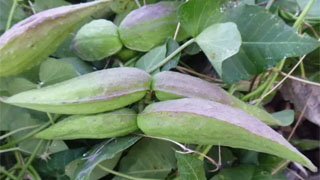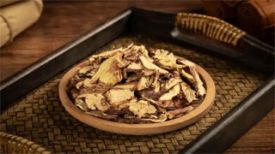
1. Aliases
Kelan, Yangjiaocai, Grandma's Needle and Thread Bag, Milk Paddle Vine, Wild Geshan Xiao.2. Plant morphology
Perennial herbaceous vine, up to 8 meters long. The whole plant has milk; The lower part of the stem is lignified, while the upper part is more flexible with longitudinal stripes. The young leaves are densely covered with short soft hairs, and the hairs gradually fall off as they age. Leaves opposite, membranous; The stalk is 3-6 centimeters long, with clustered glands at the tip; The leaves are ovate and heart-shaped, 5-12 centimeters long and 4-7 centimeters wide. The apex is short and gradually pointed, with a heart-shaped base. The leaf ears are round and 1-2 centimeters long. The upper part is green, and the lower part is pink green. Both sides are hairless; 10-12 pairs of lateral veins, slightly prominent at the back of the leaves. The racemose cyme inflorescence is axillary or extraaxillary; The total stem length is 6-12 centimeters, covered with short pubescence; Pedicels about 8 millimeters long, pubescent; Bracteoles membranous, lanceolate, apex acuminate; Calyx lobes lanceolate, outside covered with micro hairs; The corolla is white with light purple red stripes, nearly radiating; Corolla lobes open, apex reflexed, base covered to the left; Corona annular, inserted on the corolla, short 5-lobed, lobes cup-shaped; The stamens are connected to form a conical shape and surround the pistil within it; The pollen blocks droop; The ovary is composed of 2 free carpels, hairless, with the stigma extending into a long beak and the apex 2-lobed. Follicles are forked, spindle shaped, smooth and hairless, measuring 8-9 centimeters in length. The apex is gradually pointed, and the base is enlarged. The seeds are flat, brown, with membranous edges, and the apex has white silky seed hairs. The flowering period is from July to August, and the fruiting period is from September to December.
3. Origin distribution
Born in wasteland by the forest, by the river, and in shrubs by the roadside. Distributed in Northeast China, North China, East China, as well as Shaanxi, Gansu, Henan, Hubei, Hunan, Guizhou and other places.
4. Harvesting and processing
Harvest the whole grass from July to August, fresh or sun dried. Harvest, wash, and sun dry the tubers in summer and autumn.
5. Characteristics of medicinal herbs
Often single or several strands twisted in a bundle shape, with varying lengths. The stem is long cylindrical, slightly skewed, slightly twisted, and branched. A diameter of 1.5 centimeters; The surface is gray white or light yellow green, with longitudinal stripes and knots; The quality is flexible or slightly brittle, and the broken skin is strong and fibrous. The woody part of the old stem is obvious, often in a crescent to crescent shape, with numerous pores visible and hollow pulp. The leaves are opposite and often wrinkled. After flattening, the leaves are ovate heart-shaped to long ovate, 4-10 centimeters long and 3-8 centimeters wide; The top is gradually pointed, the base is heart-shaped, whole or microwave shaped, with a withered yellow or light yellow green color on the top and a light or pink yellow color on the back, with a long stalk. The raceme is covered with grayish white pubescence. Follicles are long and ovate or ovate and lanceolate. The top of the seed has a cluster of white long silky hairs. Slight breath, light taste.
6. Nature, taste, and meridian tropism
Mild in nature, sweet and spicy in taste. Guipi Meridian, Lung Meridian, and Kidney Meridian (Jilin Province Traditional Chinese Medicine Standards Volume 1 (2019 Edition)).
7. Effect and function
Nourishing essence and qi, promoting lactation, and detoxifying. A Yang tonifying medicine belonging to the subcategory of tonifying deficiency medicine.
8. Clinical applications
Internal administration: decoction, 15-60 grams. External use: Fresh products in moderation, mashed and applied. Indications include fatigue injury, impotence, nocturnal discharge, insufficient milk, erysipelas, scrofula, boils, and snake and insect bites.
9. Pharmacological research
It has anti-tumor, hypoglycemic, lipid-lowering, and anti fertility effects.
10. Chemical composition
This product contains ester type glycosides, benzoyl resveratrol, coumarin, isotherm, coumarin, coumarin, coumarin, coumarin, dibenzoyl resveratrol, deacetylated coumarin, deacetylated cowhide glycoside, nocturnin, and hydroxylated coumarin.
11. Taboos for use
Elderly, weak, and Qi deficient individuals should take medication with caution, and pregnant women should not take it.
12. Compatibility prescription
① Treatment of impotence: 9g each of the roots of Chinese wolfberry, Epimedium, and Xianmao. Boiled in water, 1 dose per day. (Jiangxi Herbal Medicine)
② Treatment of tuberculosis injury: Asclepiadaceae root, stewed in chicken. (Sichuan Journal of Traditional Chinese Medicine, 1960 edition)
③ Lower breast: 9-15 grams of Asclepiadaceae, boiled in water for consumption; Stewed meat suits can be used for 30-60 grams. (Compilation of Commonly Used Folk Herbs)
④ Treatment of scrofula: 30g of Asclepiadaceae root. Boiled in water, 1 dose per day. (Jiangxi Herbal Medicine)
⑤ Treating warts, prickly warts, and flat warts: Use a needle to puncture the affected area and see blood. Point the white juice from the stem and vine of the Chinese wolfberry, let it dry on its own, and it will heal in one go. (Jilin Chinese Herbal Medicine)
The content of the article is for clinical reference only. Non professionals in traditional Chinese medicine are not allowed to try medication.


